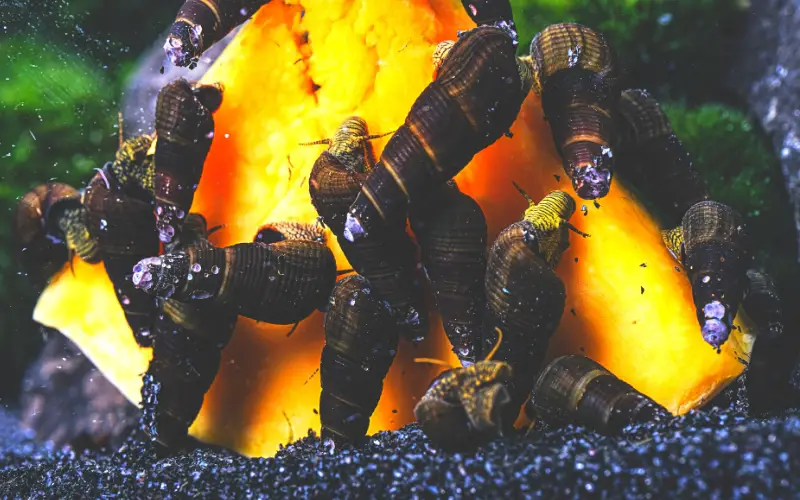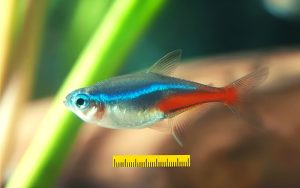What are common rabbit snail colors? Rabbit snails, also known as Tylomelania, are a unique and fascinating species of freshwater snails that come in a wide array of stunning colors. These vibrant creatures are a popular choice among aquarium enthusiasts for their striking appearance and exciting behavior.
In this article, we will delve into the world of Rabbit snails colors and explore some of the most unique shades that you won’t believe exist.
From bold and eye-catching hues to subtle and understated tones, elephant snails come in a dazzling spectrum of colors that are sure to capture your imagination.

Whether you prefer the vibrant oranges and yellows of a Sunshine Rabbit snail, the deep blues and purples of a Blue Rabbit snail, or the delicate pinks and whites of a Sakura Rabbit snail, there is a color variation to suit every taste and aesthetic.
Join us as we take a closer look at the myriad of stunning colors that Rabbit snails can come in and discover the beauty and diversity of these incredible creatures.
Get ready to be amazed by the breathtaking shades that Rabbit snails have to offer!
Table of Contents
ToggleRabbit Snail Species Overview:
Rabbit snails come in various colors, such as chocolate, orange rabbit snails, and yellow and black rabbit snails.
The rabbit snails can grow up to 3 inches in length and are typically found in Sulawesi, Indonesia, in areas like Sulawesi. In a planted aquarium, rabbit snails make great additions as they help clean up algae and biofilm.

When it comes to rabbit snail care guides, it is essential to provide them with a suitable tank size and a substrate like driftwood to mimic their natural habitat. Rabbit snails reproduce by laying eggs and can produce one or two baby snails at a time.
Rabbit snails are considered compatible with shrimp and other community tank fish species. They feed on pellets, decay, and other food sources available in the tank. With a moderate hardness level, rabbit snails can thrive well in a tank setup.
Compared to other snail species like mystery snails and nerite snails, rabbit snails are known for their bright colors and unique appearance. If you have a gallon tank, consider adding a famous rabbit snail to your collection for a vibrant touch.
7 Common Rabbit Snail Colors
Rabbit snails come in a surprising variety of colors, making them a popular choice for aquariums. Here are seven popular rabbit snail colors:
1. Golden Rabbit Snail: Named for its golden-yellow body, these snails usually have dark brown or black shells with 9 to 10 whorls.
2. Orange Poso: This species exhibits a bright orange coloration with a dark brown or black shell. Orange poso snails reach up to five inches long.
3. Rabbit Snail Colors Yellow Poso: A selectively bred variety of the orange poso, this snail has a yellow body and either a dark brown or mixed light-and-dark shell.
4. Chocolate Rabbit Snail: These rabbit snails exhibit a chocolate brown body coloration and a sandy shell color.
5. Black Rabbit Snail: A rare variety with an unknown species name, the black rabbit snail has a black body and matching black shell.
6. White Rabbit Snail Colors: This species has a salt-and-pepper coloration—a black body dotted with tiny white spots. Their shells come in various shades of brown, red, and white spotted rabbit snails.
7. Gold-Spotted Rabbit Snail: Similar to the previous variety, these rabbit snails have dark bodies dotted with golden yellow spots.
What are Rare Rabbit Snail Colors?
There are a few varieties of rabbit snails that are considered rare in the aquarium hobby. Here are two of the rarest:
- Black Rabbit Snail: This snail has a black body and a black shell, making it quite a sight to see in a freshwater tank. Unfortunately, the specific species of this black rabbit snail is unknown.
- Sulawesi King Rabbit Snail: This aquatic mollusk is one of the most sought-after snails due to its rarity. It has a light brown spiral shell with horizontal stripes and can grow up to 3 inches long. Their bodies are a light brown color.
Factors Influencing Rabbit Snail Colors
Rabbit seashells, on the other hand, are colorful seashells that come from a sea snail called Cyphoma gibbosum. These marine snails come in a variety of colors, including orange, yellow rabbit snails, pink, and purple.
The factors influencing the shell color of Cyphoma gibbosum are:
- Diet: The algae that rabbit snails eat contain pigments called carotenoids, which are deposited in their shells as they grow [1]. A diet rich in specific carotenoids can result in brighter shell colors.
- Genetics: Just like with eye color in humans, the genes of the snail play a role in determining the primary color range of their shell.
- Habitat: The water conditions, such as temperature, light availability, and mineral content, can also influence the coloration of the snail’s shell.
If you’re interested in learning more about snail shell colors, I can provide some information on that!
Rabbit Snail Care Requirements: (Tips for Care and Breeding)
Rabbit snails are a unique species of aquarium snails that come in a variety of different colors, such as orange, yellow, rabbit snail colors green, and small white. These cone-shaped snails can also be kept in planted tanks, where they typically reach around 1.5 inches in size.
To keep your rabbit snails happy and healthy, make sure to provide them with an aquarium substrate to burrow in, decoration for climbing, and a diet of algae wafers, blanched vegetables, and decaying plant matter.
Fortunately, these omnivorous snails are quite active and make great tankmates for freshwater shrimp. With the proper filtration and water parameters, rabbit snails can live for years in your aquarium. If you have any tips or suggestions for rabbit snail care, feel free to leave a comment below!
Rabbit snails belong to the genus Tylomelania and are known for their exotic appearance, resembling rabbit ears. These fascinating aquatic creatures are a great addition to any aquarium, adding a pop of color and interest to your tank.
Keeping rabbit snails can be a rewarding experience, as they are relatively easy to care for and maintain healthy if the conditions are right.
With proper care and attention, rabbit snails can thrive and even breed in your aquarium. Consider adding these unique aquarium snails to your tank for a touch of individuality and beauty.
Frequently Asked Questions about Rabbit Snail Shell Colors (FAQs)
Are rabbit snails prone to losing color over time?
Rabbit snails would retain their vibrant colors with proper care and maintenance. However, environmental stressors or inadequate nutrition may lead to fading over time.
Can rabbit snails change colors in response to their surroundings?
While rabbit snails exhibit slight color variations based on environmental factors, dramatic changes are primarily influenced by genetics and breeding.
Do all rabbit snail species display vibrant colors?
While many rabbit snail species boast striking colors, some variants may have more subdued hues, reflecting their natural habitat and genetic makeup.
How can I enhance the colors of my rabbit snails?
Providing a varied diet, maintaining pristine water conditions, and ensuring a stimulating aquarium environment are critical factors in enhancing and preserving the vibrant colors of rabbit snails.
Are there any health implications associated with color loss in rabbit snails?
While fading coloration may indicate underlying health issues, it is essential to assess other symptoms, such as changes in behavior or appetite, to determine potential health concerns.
Can I selectively breed rabbit snails to produce specific color variations?
Selective breeding techniques can influence the expression of specific colors in rabbit snails, allowing aquarists to cultivate unique and desirable variations over successive generations.
Do rabbit snails change color?
Rabbit snails colors can intensify or fade depending on factors such as diet, genetics, and environmental conditions.
Can you breed rabbit snails for specific colors?
Yes, selective breeding can yield rabbit snails with desired colors, although it may take several generations to achieve consistent results.
Are there rare color variations of rabbit snails?
Yes, some color morphs of rabbit snails tylomelania gemmifera, are considered rare and highly sought after by collectors and enthusiasts.
How do I maintain vibrant colors in my rabbit snails?
Providing a balanced diet, optimal water parameters, and a suitable environment is crucial in maintaining vibrant colors in rabbit snails.
Are rabbit snails sensitive to changes in water quality?
Yes, elephant snails are sensitive to fluctuations in water quality, so it’s essential to maintain stable conditions to ensure their health and coloration.
Conclusion
In conclusion, the world of rabbit snail shell colors is truly a sight to behold. From the striking crimson reds to the delicate pastel blues, these enchanting creatures never fail to mesmerize. Their vibrant hues create a captivating display, breathing life and vibrancy into any aquarium or aquatic environment.
By delving into the realm of rabbit snails colors, we gain a deeper appreciation for the wonders of nature. The intricate patterns and shades they exhibit showcase the diversity that exists within our natural world. Whether you’re a seasoned aquarist or simply an admirer of aquatic life, witnessing these snails in all their colorful glory is an experience that leaves a lasting impression.
So, if you’re ready to add a splash of brilliance to your aquarium or want to immerse yourself in the beauty of nature, consider welcoming rabbit snails into your aquatic family. Their captivating colors will undoubtedly bring joy and wonder to your underwater world. Explore the kaleidoscope of rabbit snail colors and unlock a world of aquatic fascination today!
You might also like
- Rabbit Snail Tank Size 101: Setting Up the Perfect Aquarium
- Rabbit Snail Breeding 101: A Comprehensive Beginner’s Guide
- Golden Rabbit Snail 101: Tank Requirements & Care Tips
- How Long Do Rabbit Snails Live: (A Complete Care Guide)
- What Do Rabbit Snails Eat: (5 Foods They Can’t Resist!)
- Do Rabbit Snails Reproduce Asexually: (The Shocking Truth)
- Will Rabbit Snails Eat Algae: You WON’T Believe What They Do!
- Tylomelania White Spotted Rabbit Snail 101: (A Comprehensive Care Guide)





